|
Magic Lanterns, manufactured by Gebrüder Bing Nürnberg part 1 |
 One of the most famous Nuremberg toy manufacturing companies is the firm of the 'Gebrüder Bing'. Ignaz Bing and his brother Adolph founded a retail company selling household items round 1863 and began to manufacture their own stock in the late 1870s. Some ten years later they started manufacturing tin toys, at first equipment for dolls' kitchens, later on also steam engines and model trains. The first advertisements for magic lanterns appeared in 1866.  By the turn of the century the firm employed several thousands of workers and was a leading international toy manufacturer. It was one of the few to flourish after the First World War, but the Great Depression of 1929 was disastrous. After 1931 the production was wound up and was partly taken over by other Nuremberg companies like Johann Falk. The Bing company still remains active as a toy manufacturer, though the production is radically changed. Trade marks. |
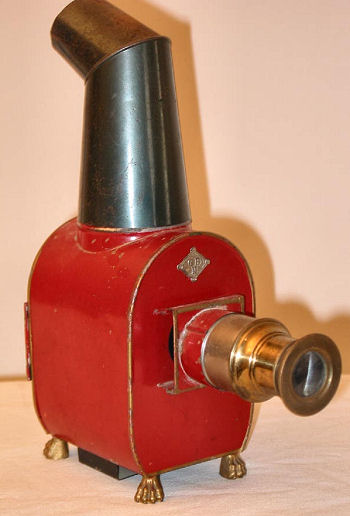 |
Model 'Silvana'. Red lacquered tin magic
lantern. This oval 'mailbox-type' of magic lantern was also produced by several
manufacturers, like Ernst Plank,
Schoenner and Carette. Brass objective. Gold painted claw feet. |
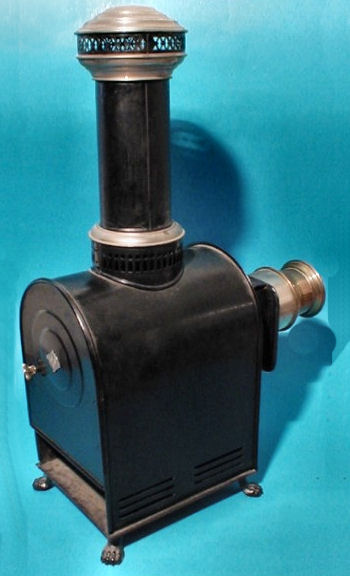 |
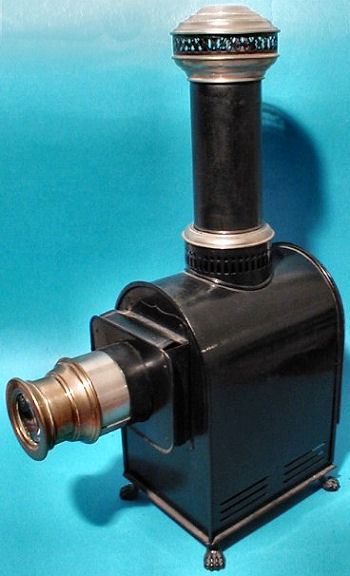 |
|
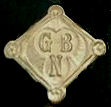 Model 'Helios'. Fitted with double condensor, objective with 3 lenses. Black lacquered tin plate. Tiger claw feet. Ca. 1905.
|
||
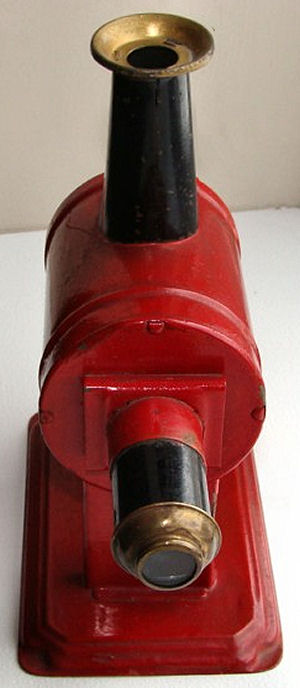 |
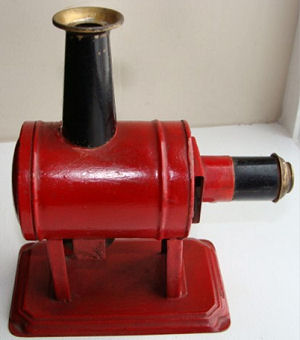 |
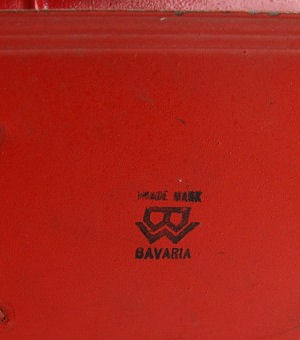 |
|
This kind of red lacquered, barrel shaped
tin magic lantern is from ca 1895. Similar lanterns are produced by almost
all Nuremberg's toy manufacturers. It was cheap and uncomplicated and
suitable to the use of a simple candle. |
||
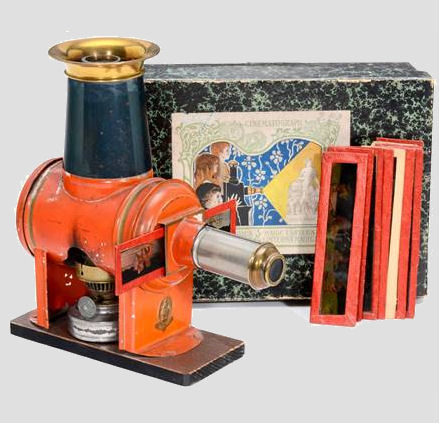 |
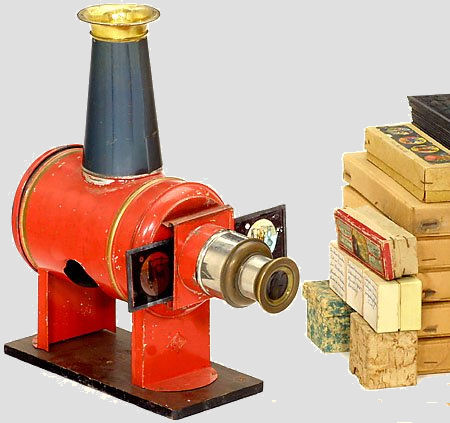 |
|
Two similar barrel shaped magic lanterns provided with
a wooden base and different chimneys. |
|
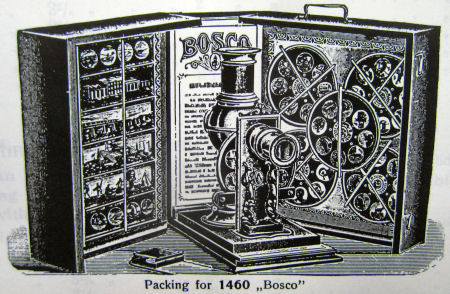
|
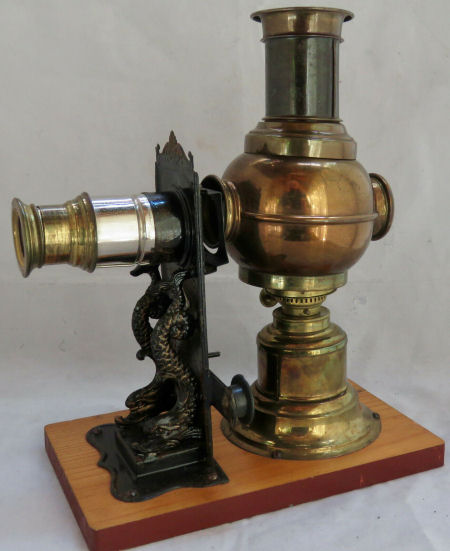 |
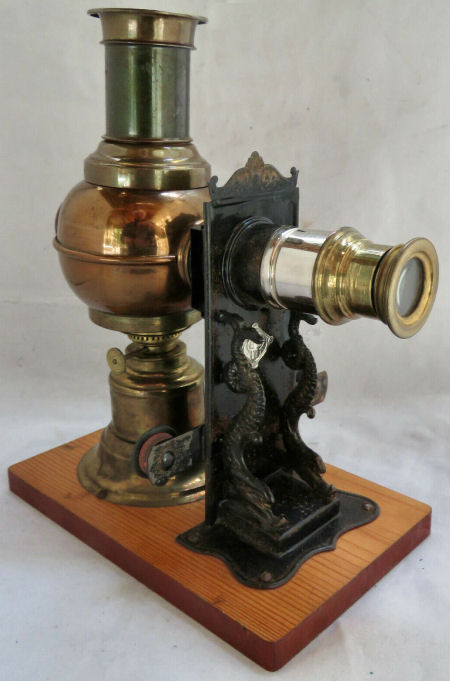 |
 |
|
Simple
black toy lantern. Diamond-shaped 'GBN'-emblem attached on the door. It is 11.5 inches tall to top of chimney, 11 inches long from edge to lens and 4 inches wide (29 x 28 x 10 cm). |
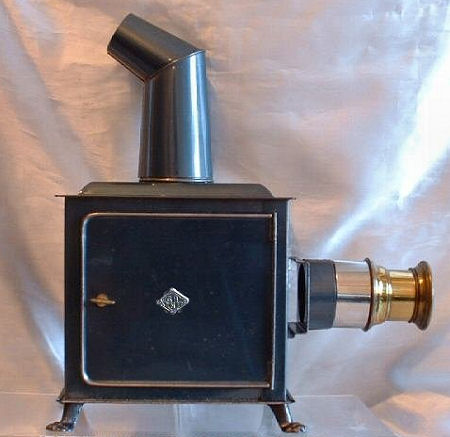 |
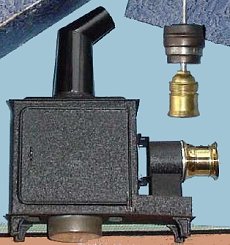 |
This relative modern Bing magic lantern includes
a tiny oil lamp as well as an adapter for electric use (bulb). It is made of
black hammer-scale lacquered tin. A label with the "BW" trade mark is on top of the original cardboard box. The box includes a smaller box containing 12 slides 2" x 7" (5 x 18 cm). Sizes of the lantern are 6" tall and 9" (15 x 23 cm) deep without chimney. |
|
Scio 3767 model, 1910. Described in the 1912 catalogue as a "Very fine
Magic Lantern, elegant shape, polished Russian iron, with 12 glass
slides in separate grooved box. All packed in a fine strong cardboard
box". The price was 5 shillings. The GBN trademark is impressed on the door, a German patent mark DRGM is impressed on the front under the lenses. The main blue box has a mottled finish and measures 10.5 inches x 7 inches (27 x 18 cm) and the lantern stands about 10 inches (25cm) high with the chimney fitted. The lantern stands on gold painted lion-claw feet and has a lacquered brass lens. |
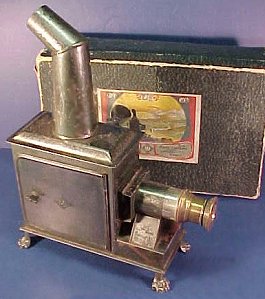
 |
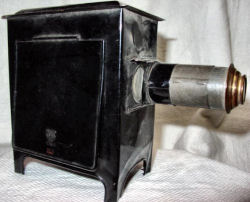 |
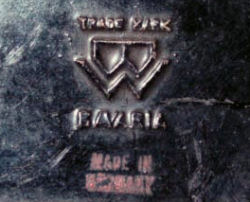 |
| This simple Bing magic lantern is embossed on the flap with the BW-logo and is stamped in red with the words Made in Germany. It measures 6" in height by 2 7/8" wide and is 7 ¾" long, including the extended lens piece. | |
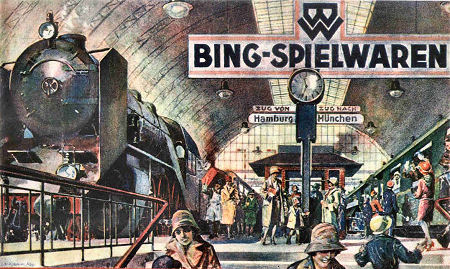 |
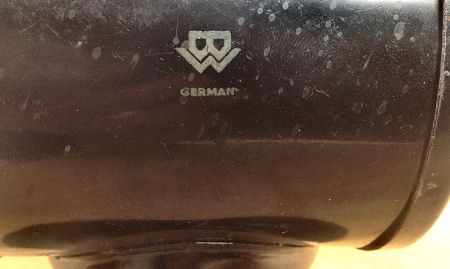 |
 Cover of the 1930 Catalogue of the at the time 'Gröste Spielwarenfabrik
der Welt' Bing Werke in Nuremberg, Germany. The trade name 'Gebrüder
Bing Nürnberg' had already been changed to 'Bing Werke'.
The diamond-shaped G.B.N. trade mark was replaced by a horizontal B and W.
Sometimes lanterns of the type below were still available with a combined trademark.
Cover of the 1930 Catalogue of the at the time 'Gröste Spielwarenfabrik
der Welt' Bing Werke in Nuremberg, Germany. The trade name 'Gebrüder
Bing Nürnberg' had already been changed to 'Bing Werke'.
The diamond-shaped G.B.N. trade mark was replaced by a horizontal B and W.
Sometimes lanterns of the type below were still available with a combined trademark.The catalogue has 76 pages and the dimensions are 30 x 22 cm. |
|
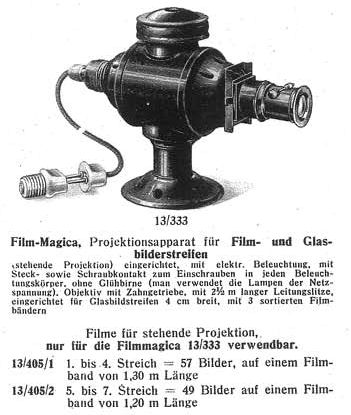 |
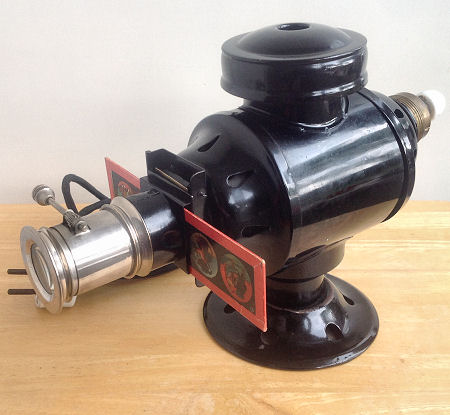 |
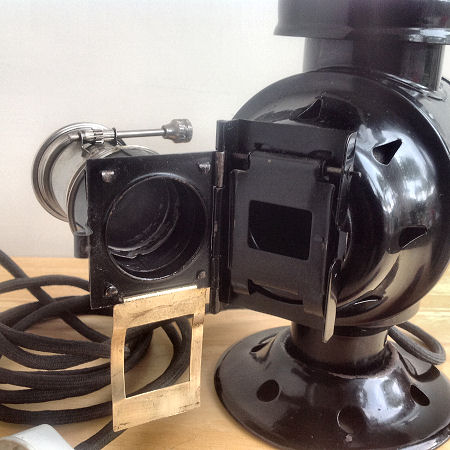 |
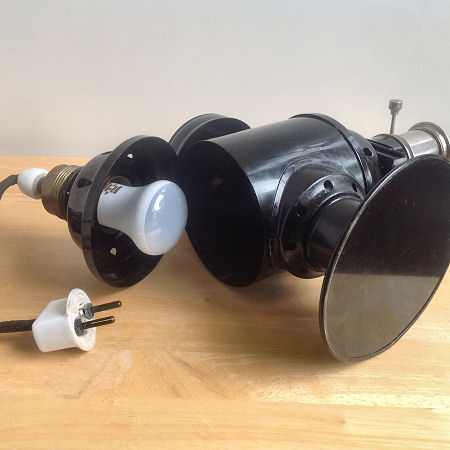 |
| This model 13/333 is mentioned in the 1930 Catalogue. The lantern is suitable for showing long glass magic lantern slides as well as projecting film strips (stationary projection). Focusing is done by a 'rack and pinion system'. Suitable for lantern slides of 4 cm wide; the film strips used were about 1.25 m long and contained about 55 images. A handy accessory was supplied with which the porcelain plug could be screwed into the socket of a light bulb. | |
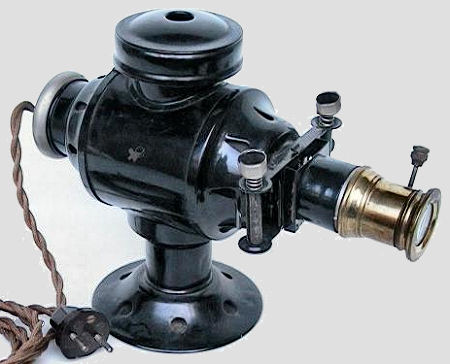 The same model lantern, now equipped with a somewhat better film transport mechanism. |
 |
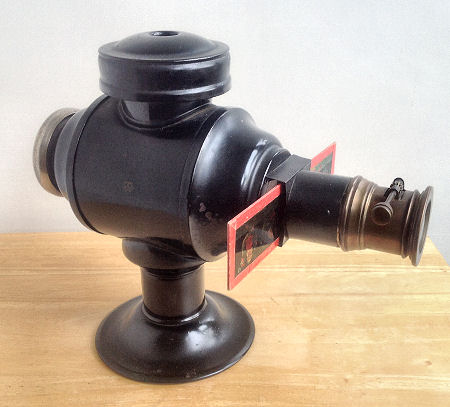 |
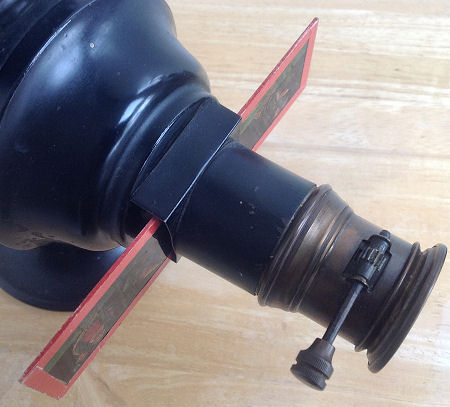 |
| This model is only suitable for projecting glass slides of 4 cm wide. Here, too, focusing takes place by means of a 'rack and pinion system'. On one side of the body we find the BW trademark. This model differs from the previous one due to the lack of openings in front, back and foot. | |
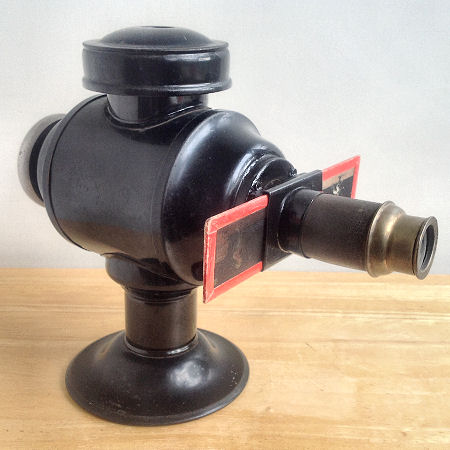 |
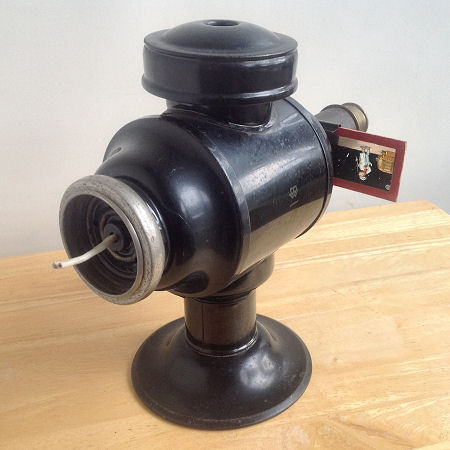 |
| This model is also only suitable for projecting glass slides of 4 cm wide. Here focusing takes place simply by moving the projection lens in or out. On one side of the body we find the BW trademark again. Also this model lacks the openings in front, back and foot. | |
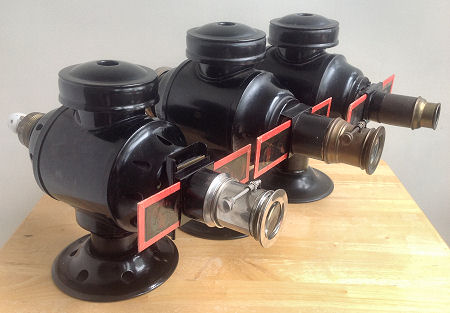 |
The dimensions of these magic lanterns are
approximately 22 cm high, 26 cm long and 12 cm wide. They are made of black painted tin with brass or
chromed parts. Small can for a film strip. |
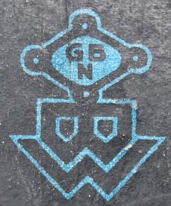
The Filmmagica released by GBM / BW was such a special model that the cardboard box in which the magic lantern was packed was provided with a special label. |
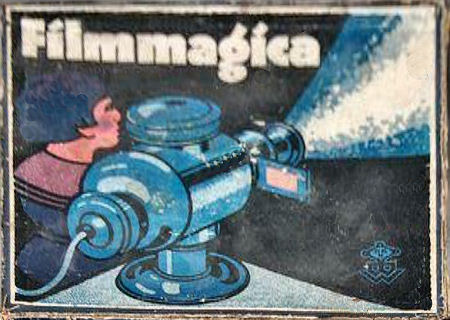 |
|
Meer Bing lantaarns...... |
|
|
|
©1997-2021
'de Luikerwaal' All rights reserved. Last update: 19-05-2021. |
|
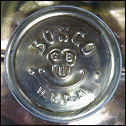 The
'Gebrüder Bing' made only one model
magic lantern that was suitable for displaying
The
'Gebrüder Bing' made only one model
magic lantern that was suitable for displaying